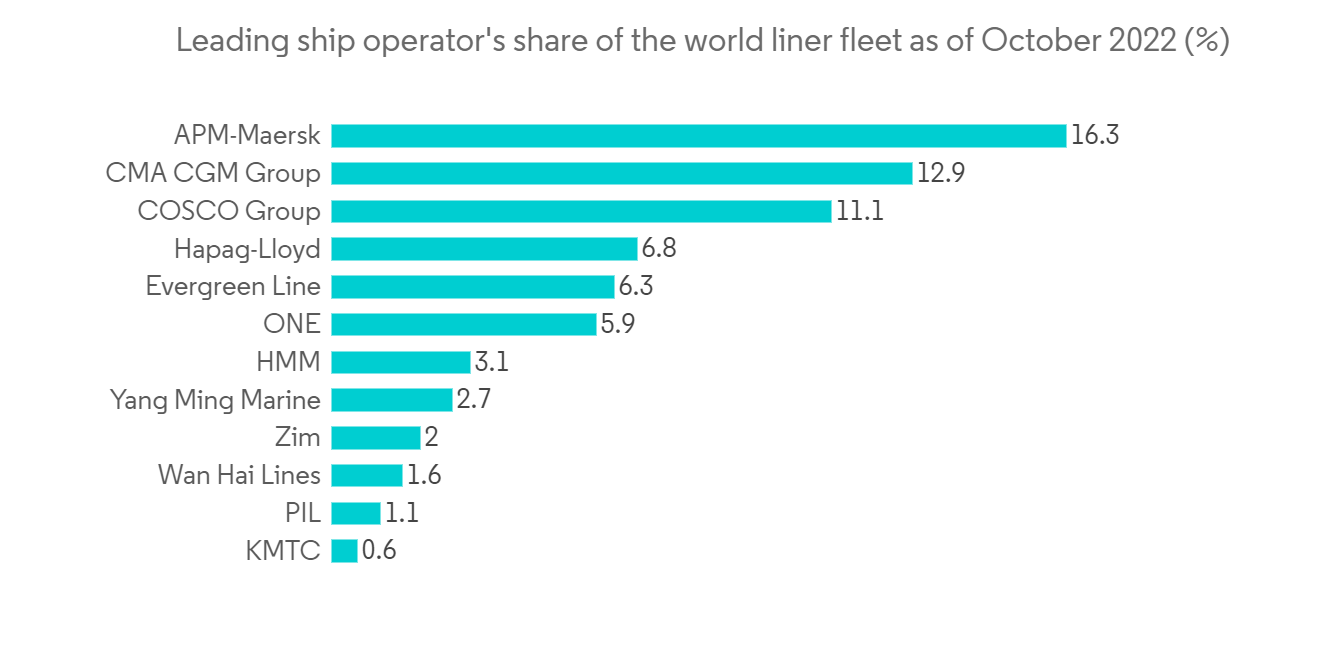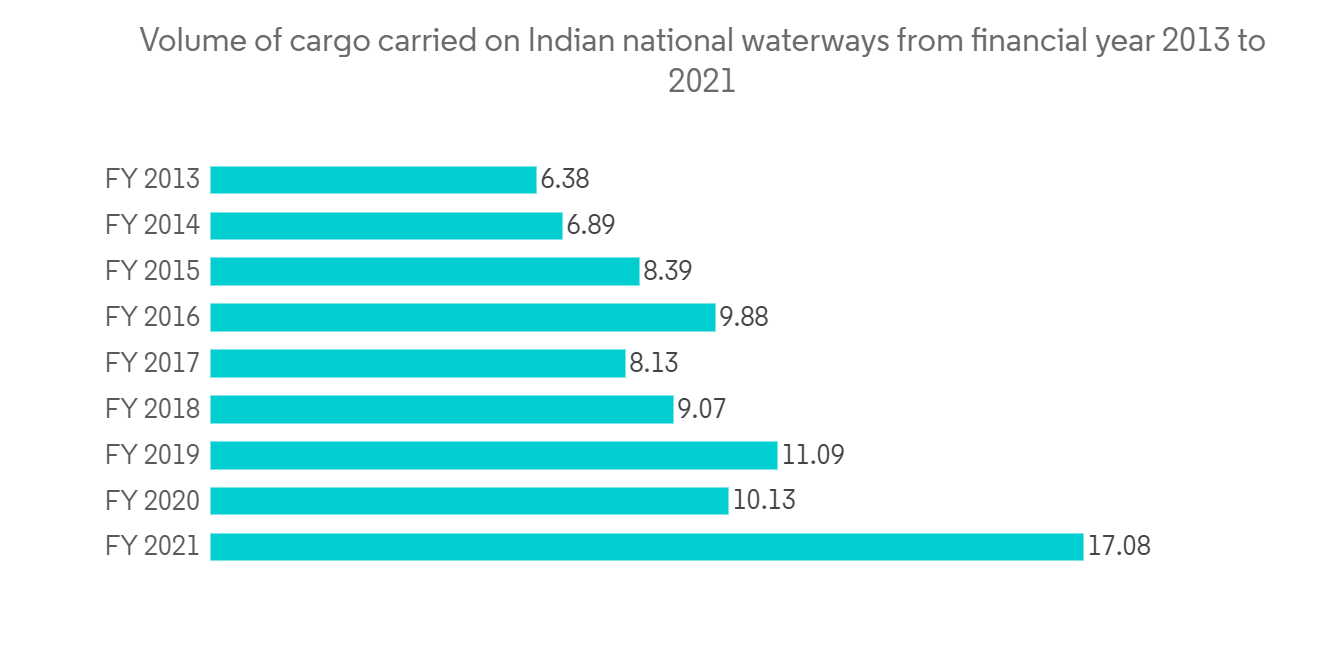PUBLISHER: Mordor Intelligence | PRODUCT CODE: 1248152

PUBLISHER: Mordor Intelligence | PRODUCT CODE: 1248152
Inland Water Freight Transport Market - Growth, Trends, And Forecasts (2023 - 2028)
The size of Inland Water Freight Transport market is USD 13.25 billion in the current year and is anticipated to register a CAGR of over 3% during the forecast period
Key Highlights
- The inland water freight transportation market comprises companies (organizations, sole proprietors, and partnerships) that offer inland water freight transportation of cargo on lakes, rivers, or Intracoastal waterways. Only items and services that are exchanged between parties or sold to final customers are covered.
- The market for inland water freight transport has been primarily driven by the need for reasonable cargo transportation. Because of the discrepancy in fare pricing compared to other means of shipping, water freight is typically regarded as affordable and economical for heavy items. The cubic meter of the typical container is frequently used to determine the rate of water transportation. In contrast, the charged weight for air transportation is determined by taking into account both the size and weight of the cargo.
- An growing trend in the inland water freight transport business is the creation of information technology platforms for better vessel management. According to the United Nations Conference on Trade and Development (UNCTAD), in 2019, with a fleet of 95402 ships, nearly 80% of world trade was handled via waterways. Information technology is utilized on ships for customer relationship management, warehouse management, queuing systems, fuel optimization, monitoring vessel performance, and document recognition from scanned copies and images. BunkerEx, an online resource that assists ship owners in locating the best bunker ports, and Nautilus Labs, which uses data from sensors, manual reports, and market information to create a unified fleet intelligence, are two notable examples of online tools and portals used for operations management on ships.
- The market for inland water freight transport is anticipated to be hampered during the term due to the impact that crude oil price volatility is having on the water transportation industry. Fuel oil, which provides 95% of the energy used in worldwide transportation, is a significant source of powering the global economy, according to the United Nations Conference on Trade and Development. Increased fuel prices lead to product inflation and have an impact on all facets of product transportation. When fuel prices decline, consumers can purchase items for less, and logistics companies can utilize the money they save to enhance their operations. Operational costs are directly affected by variations in fuel prices.
- Although the COVID-19 epidemic affected marine travel, the effects were not as severe as first anticipated. Maritime trade decreased by 3.8% in 2020 as a result of the shock in the first half of the year. However, there was a tentative, though asymmetrical, recovery in the second half of the year, and by the third quarter, volumes had restored for both containerized trade and dry bulk commodities.
Inland Water Freight Transport Market Trends
Increasing use of AI and Data analytics platform for better vessel management
A growing trend in the inland water freight transport business is the creation of information technology platforms for better vessel management. With the use of cloud-based services that permit remote access to information, software solutions designed for vessel management assist in managing and organizing all vessel operations, including crew administration, communications, and ship-based service requests, from the office.
Seamless application of vessel monitoring solutions enables operators to track their vessel movements and allows crew members to share shipboard data with headquarters for further analysis, simplifying the decision-making processes and improving operational efficiency.
For the purpose of reducing GHG emissions and fuel costs, maritime enterprises are increasingly aiming to employ energy-efficient integrations. This calls for upgrading a number of systems on board the ship, from the scrubber and rudder to the lubrication, coatings, and propulsion units. For instance, while some businesses focus on improving ship and exhaust design, others offer waste heat recovery technologies. With the help of these additions, maritime businesses may dramatically increase the sustainability of their operations while spending less on fuel and energy.
Artificial intelligence is used in the marine industry for a variety of purposes, including route optimization, autonomous navigation, and predictive maintenance. The crucial purpose of AI in these processes is to digest the enormous amounts of data made available by sensors, public information systems, and asset tracking in order to produce insights that may be put to use. Startups use the analyzed data to increase forecasting precision and save operating, maintenance, and fuel costs. In addition, AI in underwater robots and vehicles makes it easier to conduct search and rescue missions and aid in underwater repairs. Startups also offer digital twins of fleets, ports, and ships that use AI to continuously monitor their operations and enhance vessel and port management.
In order to stay competitive, many leading ocean carrier businesses are currently automating their processes, robotizing certain job functions, digitizing data, utilizing the cloud, the IoT, etc. Therefore, they are not far from being interested in autonomous navigation because it offers advantages in terms of transportable cargo volume, reduction of environmental pollution, reduction of operating costs, and reduction of operating time, all of which would enable them to increase the number of trips and the service they provide to their clients, which includes freight forwarders.

Asia Pacific is the fastest growing market for inland water freight transport
Comparing inland canal transportation to land-based systems, which frequently struggle with congestion and capacity issues, it is generally agreed that inland waterway transportation is the cleanest, safest, and most energy-efficient means of transportation. Inland water transportation can be encouraged as a modal shift alternative to road transportation, which may reduce the number of traffic accidents involving large goods vehicles. For instance, only 5% of all vehicles in India are trucks, but they cause 26% of all traffic accidents. Additionally, by establishing a shared transportation route between multiple nations that share a river, inland waterway transportation has the potential to enhance regional cooperation and integration. This may be seen in the way that Europe has made use of rivers like the Danube and Rhine to promote trade within the continent.
India wants to expand its ambition to connect rivers throughout Southeast Asia all the way to Thailand in an effort to interconnect local river channels and boost trade. Shippers, logistics players, and cargo owners should benefit from the planned international waterways network, which will span over 5,000 km and pass through eight nations. Over USD 50 billion in trade is thought to be possible through the network. The Myanmar seaport at Sittwe has already been constructed by India. It is now usable for navigation. Since Sittwe and Mizoram are connected by rivers, this development will be advantageous for both Mizoram and Tripura as it facilitates international trade. New economic routes with Myanmar, Singapore, and Thailand are anticipated to emerge once these inland waterways are connected with coastal shipping, creating a cascade of various repercussions throughout the region.

Inland Water Freight Transport Market Competitor Analysis
American Commercial Barge Line, Ingram Barge, Kirby Inland Marine, American River Transportation, CMA CGM Group, McKeil Marine Limited, AP Moller-Maersk A/S, Rhenus Group, and Imperial Logistics International are significant market participants. As Inland water transportation is the next big thing in green cargo, the development of inland waterways will help in the protection and conservation of waterways and canals. The transportation of raw materials represents a sizable market for Inland water transport. Production quantities of plants supplied by waterways and transport volumes are connected. If there is a trustworthy waterway link and access close to the facility, Inland water transport can be more affordable than railways. Thus considering cost efficiency and transport route feasibility the market is expanding.
In June 2022, The B20 Club added the American River Transportation Co. (ARTCO) as its newest member. ARTCO, a wholly owned subsidiary of Archer Daniels Midland Co., operates line-haul vessels, harbor boats, covered-hopper barges, tank barges, harbor and fleeting services, and a full-service shipyard. These operations allow ARTCO to deliver products to their final destination in a safe and efficient manner. ARTCO also provides a third-party towing service on the lower and upper Mississippi, and on the Illinois and Ohio rivers.
Additional Benefits:
- The market estimate (ME) sheet in Excel format
- 3 months of analyst support
TABLE OF CONTENTS
1 INTRODUCTION
- 1.1 Market Definition and Scope
- 1.2 Study Assumptions
2 RESEARCH METHODOLOGY
3 EXECUTIVE SUMMARY
4 MARKET DYNAMICS AND INSIGHTS
- 4.1 Current Market Scenario
- 4.2 Market Dynamics
- 4.2.1 Drivers
- 4.2.2 Restraints
- 4.2.3 Opportunities
- 4.3 Industry Attractiveness - Porter's Five Forces Analysis
- 4.3.1 Threat of New Entrants
- 4.3.2 Bargaining Power of Buyers/Consumers
- 4.3.3 Bargaining Power of Suppliers
- 4.3.4 Threat of Substitute Products
- 4.3.5 Intensity of Competitive Rivalry
- 4.4 Value Chain/Supply Chain Analysis
- 4.5 Technological Advancements
- 4.6 Government Regulations and Key Initiatives
- 4.7 Insights into Transshipment Trade
- 4.8 Insights into Containerized and Non-containerized Shipments
- 4.9 Freight Rates and Maritime Transport Costs
- 4.10 Insights into Intermodal/Container Utilization
- 4.11 Demand-Supply Analysis
- 4.12 Impact of COVID-19 on the Market
5 MARKET SEGMENTATION
- 5.1 Type of Transportation
- 5.1.1 Liquid Bulk Transportation
- 5.1.2 Dry Bulk Transportation
- 5.2 Vessel Type
- 5.2.1 Cargo Ships
- 5.2.2 Container Ships
- 5.2.3 Tankers
- 5.2.4 Other Vessel Types
- 5.3 Geography
- 5.3.1 North America
- 5.3.1.1 US
- 5.3.1.2 Canada
- 5.3.2 Europe
- 5.3.2.1 Germany
- 5.3.2.2 Netherlands
- 5.3.2.3 Romania
- 5.3.2.4 Belgium
- 5.3.2.5 France
- 5.3.2.6 Rest of Europe
- 5.3.3 Asia Pacific
- 5.3.3.1 India
- 5.3.3.2 China
- 5.3.3.3 Japan
- 5.3.3.4 Australia
- 5.3.3.5 Rest of Asia-Pacific
- 5.3.4 Latin America
- 5.3.4.1 Brazil
- 5.3.4.2 Argentina
- 5.3.4.3 Rest of Latin America
- 5.3.5 Middle East & Africa
- 5.3.5.1 UAE
- 5.3.5.2 Saudi Arabia
- 5.3.5.3 Rest of Middle East & Africa
- 5.3.1 North America
6 COMPETITIVE LANDSCAPE
- 6.1 Market Concentration Overview
- 6.2 Company Profiles
- 6.2.1 American Commercial Barge Line
- 6.2.2 Ingram Barge
- 6.2.3 Kirby Inland Marine
- 6.2.4 American River Transportation
- 6.2.5 CMA CGM Group
- 6.2.6 McKeil Marine Limited
- 6.2.7 AP Moller - Maersk A/S
- 6.2.8 Rhenus Group
- 6.2.9 Imperial Logistics International
- 6.2.10 Safewater Lines*
7 FUTURE OF INLAND WATER FREIGHT TRANSPORT MARKET
8 APPENDIX




